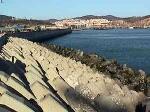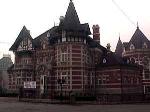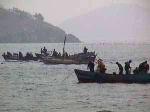- Getting around Lijiang. Dont stay in the Old Towns more than 2 days, there is nothing to do. KRISS Oct 9, 2013 05:46
- 2013 Beijing Temple Fair BENNYLAU Feb 26, 2013 03:29
- Malaysian traveling from KUL - LAX vis Shanghai PVG ZATI_DY Jan 3, 2013 20:15
The Sea Beside - Dalian
- Views: 6179
- |Vote: 2 0
- |Add to Favorites
- |Recommend to Friends
***This is the second and final part of a small retrospective series on Dalian. I lived in Dalian for two years, during which time many changes occurred. Dalian is now a thriving, modern city with many exciting attractions. However, the first time I visited, all those attractions were under construction, and Dalian was under a special period of transition. This is the story of my first visit there, which tells a lot of the sweet nature of traditional Dalian town. The places described here are still there, and more beautiful and developed today than ever before. ***
The Shores of the Bohai Gulf
My own home city is on the sea, and there was nothing more welcome than being near the water again after six months on the mainland. I'd caught glances of the ocean from the bus window whilst travelling around the city, scraps of blue placed between apartment blocks like crêpe paper. Dalian is right on the eastern tip of the Liaodong Peninsula; I considered a walk around the entire eastern coastline an achievable goal.
My guide, however, was rather more keen on busses, and on her day off she invited me to accompany her to visit a couple of Dalian's most notable seaside parks. It was a good plan; the bus to Hai Zhi Yun, on the city's northern coast, took a route through some fascinating suburbs, sandy residential blocks like the old fishing huts that once lined these streets. The bus stopped at the top of a hill above the park, which was some twenty minutes walk away down a twisting road through dry scrubland, offering a favourable view of Dalian's inner harbour.
Hai Zhi Yun is not a beach so much as a platform that extends a short way around the water edge. Tourist installations were near completion here, a windmill and what was perhaps an abseiling wall, and a series of statues that have been here a while - I'd seen photographs of them in every collection shown to me by Shenyang locals who'd visited Dalian. They depict locals in casual poses; a pair of fishermen, a teacher with a flock of schoolchildren, an elderly man playing Chinese chess which is an obligatory posing stop, as his opponent's chair is vacant for a photo opportunity.
However pretty the area was, it was also freezing in this wind; I'd left my gloves in a taxi on my first day in Dalian; the third pair I'd lost in China – my guide and I shared her pair, swapping them every few minutes. We quickly elected to walk back to the bus stop, and travel the route to its other extreme station at Lao Hu Tan Park, or Tiger Park as it is known on tourist maps.
The bus stopped in a suburb walled in by a couple of taller mounts. The buildings had a goldy glow in the sunlight that I wasn't certain I liked; many of them were hotels that were populated with attendants but which were curiously closed, every one of them, for accommodation. I was looking for a men's room and was denied entry by some very serious looking bellboys.
Lao Hu Tan was even more of a levelled wasteland than any of the other attractions I'd visited - a ticket to the park proper was ten yuan, giving entrance to enjoy rides that had not been built yet, as well as piles of broken bricks which stretched along the coast in place of a beach. It was almost an hour's stroll to the nearest public amenities which were not closed; I briefly considered boarding an old warship that has been docked as a museum, but this too was not accepting visitors. Finally we hit the tip of the park, a stunning and enormous statue of tigers looked out into a bay studded with little islands an expensive speedboat ride away.
Russian Culture Street
Foreigners often attract attention in China, but I found that in Dalian I was even more of a curiousity that I had been even in Shenyang. The reason appeared to be that all of the foreigners in the city seemed to congregate around one small area - Shanghai Lu that runs north from Zhongshan Square. It was the only place where I saw more than one foreign face; Shanghai Lu appears to be the part of town reserved for wealthy shoppers. The buildings were attractive hangovers from Dalian's colonial past and at the top of the road a street has been designated a culture zone, where renovations of old Russian buildings have created a very artificial looking Muscovite lane.
In the afternoon I visited, I was unimpressed by the pastel colours and impossibly clean and empty villas - I was rewarded, however, by a diversion down a side alley where the genuine Russian architecture remained in its original state, run down and inhabited by impoverished families making determined existences in stone homes like any other of the poorer areas in China, with the exception that their patchy houses happened to be fabulous multi-levelled European maisons, once the luxurious dwellings of Dalian's opulent invaders.
The Walk Around the Coast
I had a lot of spare time all of a sudden, after having raced around Dalian for a few days in an attempt to get to know the city well in a weekend. I relaxed my pointed exploration and settled for a more leisurely acquaintance with Dalian.
One afternoon I decided to make a first attempt at the coast walk. I located my position on a tourist map and plotted a wander to the nearest beach area - Xing Hai Park. The walk itself was most distracting; Dalian's residential areas are simple and clean, draped on a geography of natural hillocks and crests. These parts of Dalian have a genuine seaside village feeling, with the exception of the practical socialist apartment blocks which are as lacking in personality as the blue suits everyone here was forced to wear until around twenty years ago.
Xing Hai is under construction too, of course. Aside from a Chinese totem monument and a quirky brown lighthouse, the area is an almost entirely flattened plain of overturned earth. I tried to get down to the beach, but found that the only public area was a concrete walkway. The sand itself was behind a fence; a fairground with an admission fee. To me, this was poor taste, but I took a stroll along the stone pathway and enjoyed the peace. I searched for an appropriate soundtrack on a CD I'd brought with me - traditional Chinese Classical instrumental compositions. The kite flyers in the park positioned their paper birds over the dusty skyscrapers against old two-stringed violins.
I'd been aware before I'd set out that it was already too late to embark on my coast walk, so I determined an earlier departure from the flat for the next day, planning to take public transport down to Xing Hai and walk from there. Even so, I didn't make it out of the apartment until after one pm, and the foggy but cute tram ride down to Xing Hai had taken an hour by the time I was back at the park.
This time I'd brought a Faye Wong album with me, so I hooked up my headphones and started my ascent around the rising cliffs behind the Xing Hai construction sites. Grubby builders eyed me suspiciously, I couldn't care less as I started catching some of the views over the water. The islands in the Bohai Gulf seemed to arrange themselves around the old fishing boats with conscious grace, the sun on the dry grass at the roadside flaxed the cliffside to the sand. Faye was thick in soaring backing vocal overdubs; I passed the gold and silver beach areas and the Dalian zoo laid on a brushy mountainside.
When the road curved closer to Silver beach, I decided to take a walk on the sand, admiring the angular fishing vessels and relaxing in the salt breeze. I was distracted enough to take a wrong turn when I set out again, which sent me straight inland: by the time I had realised my mistake it was already evening and I again abandoned the plan to take the sea route. This was a shame; I didn't get a chance to make the walk again.
Departure
My date of leaving Dalian was quickly approaching, and the day before was a disaster – my guide broke the news to me that I couldn't stay in my flat any longer, meaning I'd have to find alternative accommodation on Saturday night before my ferry to Tianjin left on Sunday. Fortunately, she managed to locate a hostel that would put me up in a dormitory with other Chinese guests for just 25 yuan - extremely lucky, as most hotels will refuse to let such a room to a foreigner - in fact, it's against the law for foreigners to stay in less than fabulous accommodation.
I'd made a lunch appointment in the afternoon with a friend who was rather more encouraging than I'd expected - I was surprised to be invited home to meet a pair of enthusiastic parents who swiftly prepared a minor feast and was obliged to drink several large bottles of Dalian's premium beer with her father. I was chauffeured back to the hotel feeling much too indulgent and was unable to sleep in the hostel, having just made it when two other guests loudly returned to the dorm at midnight, switching on the television in our small four-man room. When they did sleep, it was without hesitation; enormous snores told of deep and blank dreams. They awoke painlessly at around 6am, making a noisy exit.
My guide arrived a few dozy hours later and assisted me with my heavy backpack as we made our several bus connections to the ferry terminal. This was an equally unsuccessful excursion: the ferry service to Tianjin (and anywhere close enough to Tianjin) was closed for the entire month of March for repair. The nice lady who'd advised us of the fares a week beforehand had neglected to make that important addition to the information she provided: NO BOAT.
As a result, I lugged the backpack around the city for a whole afternoon, and was lucky to get a suitable train ticket. After four hours of waiting in McDonald's, I finally set out, frustrated by the weekend's problems but very grateful for the extra time spent in an engaging city.
I didn't realise it then, but I had seen the last of a remote and determined Dalian. When I returned a year later, it was a completely different city – all the facilities were by then complete and the small seaside town I'd become familiar with had been replaced by a bustling and vibrant international city. Foreigners are now a significant proportion of the city's population and the attractions are plentiful and highly attractive. I'll never forget that quaint, industrious town I left behind and can only tip my hat in genuine admiration at its transformation into the butterfly of modern Dalian – perhaps the most beautiful city in China.








 Copyright © 1998-2025 All rights reserved.
Copyright © 1998-2025 All rights reserved.
1.
May 8, 2006 11:17 Reply
TOMOKU said:
Hi...^0^
im a Dalianese ,and just wanna say ur writing made me so deeply moved.and ur enthusiastic about my country...
have a nice day...